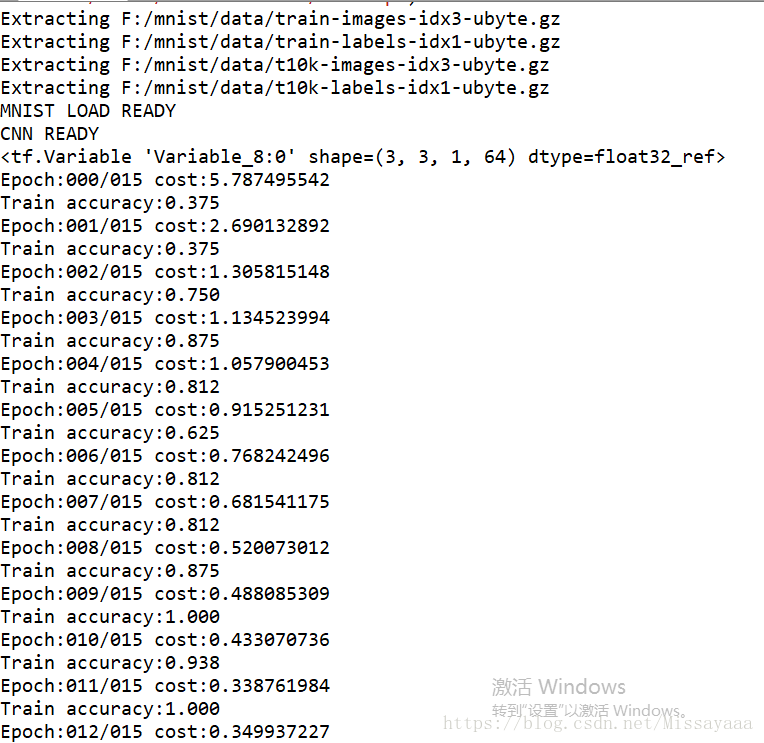tensorflow(七)实现mnist数据集上图片的训练和测试
本文使用tensorflow实现在mnist数据集上的图片训练和测试过程,使用了简单的两层神经网络,代码中涉及到的内容,均以备注的形式标出。
关于文中的数据集,大家如果没有下载下来,可以到我的网盘去下载,链接如下:
https://pan.baidu.com/s/1KU_YZhouwk0h9MK0xVZ_QQ
下载下来后解压到F盘mnist文件夹下,或者自己选择文件存储位置,然后在下面代码的相应位置改过来即可。
直接上代码:
import tensorflow as tf
import numpy as np
#引入input_mnist
from tensorflow.examples.tutorials.mnist import input_data
#加载mnist信息,获得训练和测试图片以及对应标签
mnist = input_data.read_data_sets('F:/mnist/data/',one_hot = True)
trainimg = mnist.train.images
trainlabel = mnist.train.labels
testimg = mnist.test.images
testlabel = mnist.test.labels
print("MNIST LOAD READY")
#输入图片尺寸28*28
n_input = 784
#输出类别数
n_output = 10
#初始化权重
weights = {
#卷积层参数,采用高斯初始化
'wc1':tf.Variable(tf.random_normal([3,3,1,64],stddev = 0.1)),
'wc2':tf.Variable(tf.random_normal([3,3,64,128],stddev=0.1)),
#全连接层参数
'wd1':tf.Variable(tf.random_normal([7*7*128,1024],stddev=0.1)),
'wd2':tf.Variable(tf.random_normal([1024,n_output],stddev=0.1))
}
#初始化偏置
biases = {
'bc1':tf.Variable(tf.random_normal([64],stddev = 0.1)),
'bc2':tf.Variable(tf.random_normal([128],stddev=0.1)),
'bd1':tf.Variable(tf.random_normal([1024],stddev=0.1)),
'bd2':tf.Variable(tf.random_normal([n_output],stddev=0.1))
}
#定义前向传播函数
def conv_basic(_input,_w,_b,_keepratio):
#输入
#reshape()中的-1表示不用我们指定,让函数自己计算
_input_r = tf.reshape(_input,shape = [-1,28,28,1])
#CONV1
_conv1 = tf.nn.conv2d(_input_r,_w['wc1'],strides=[1,1,1,1],padding='SAME')
_conv1 = tf.nn.relu(tf.nn.bias_add(_conv1,_b['bc1']))
_pool1 = tf.nn.max_pool(_conv1,ksize = [1,2,2,1],strides = [1,2,2,1],padding='SAME')
#Dropout层既可以使用在全连接层之后,也可以使用在每层之后,这里在每层之后都加了Dropout
_pool_dr1 = tf.nn.dropout(_pool1,_keepratio)
#CONV2
#conv2d计算二维卷积
_conv2 = tf.nn.conv2d(_pool_dr1,_w['wc2'],strides=[1,1,1,1],padding='SAME')
_conv2 = tf.nn.relu(tf.nn.bias_add(_conv2,_b['bc2']))
_pool2 = tf.nn.max_pool(_conv2,ksize = [1,2,2,1],strides = [1,2,2,1],padding='SAME')
_pool_dr2 = tf.nn.dropout(_pool2,_keepratio)
#向量化 全连接层输入 得到wd1层的7*7*128的shape 然后转化为向量
_dense1 = tf.reshape(_pool_dr2,[-1,_w['wd1'].get_shape().as_list()[0]])
#FULL CONNECTION1
_fc1 = tf.nn.relu(tf.add(tf.matmul(_dense1,_w['wd1']),_b['bd1']))
_fc_dr1 = tf.nn.dropout(_fc1,_keepratio)
#FULL CONNECTION2
_out = tf.add(tf.matmul(_fc_dr1,_w['wd2']),_b['bd2'])
#输出字典
out = {'input_r':_input_r,'conv1':_conv1,'pool1':_pool1,'pool1_dr1':_pool_dr1,
'conv2':_conv2,'pool2':_pool2,'pool_dr2':_pool_dr2,'dense1':_dense1,
'fc1':_fc1,'fc_dr1':_fc_dr1,'out':_out
}
return out
print("CNN READY")
a = tf.Variable(tf.random_normal([3,3,1,64],stddev=0.1))
print(a)
a = tf.Print(a,[a],"a: ")
init = tf.global_variables_initializer()
sess = tf.Session()
sess.run(init)
#填充
x = tf.placeholder(tf.float32,[None,n_input])
y = tf.placeholder(tf.float32,[None,n_output])
keepratio = tf.placeholder(tf.float32)
#进行一次前向传播
_pred = conv_basic(x,weights,biases,keepratio)['out']
#计算损失
cost = tf.reduce_mean(tf.nn.softmax_cross_entropy_with_logits(logits = _pred,labels=y))
#定义优化器
optm = tf.train.AdamOptimizer(learning_rate = 0.001).minimize(cost)
#比较预测的标签和真实标签是否一致,一致返回True,不一致返回False
#argmax找到给定的张量tensor中在指定轴axis上的最大值/最小值的位置,0为每一列,1为每一行
_corr = tf.equal(tf.argmax(_pred,1),tf.argmax(y,1))
#True转化为1 False为0
accr = tf.reduce_mean(tf.cast(_corr,tf.float32))
#每1个epoch保存一次
save_step = 1
#max_to_keep最终只保留三组模型,即(12 13 14)
saver = tf.train.Saver(max_to_keep=3)
#控制训练还是测试
do_train=1
init = tf.global_variables_initializer()
sess = tf.Session()
sess.run(init)
#训练15个epoch
training_epochs = 15
batch_size = 16
display_step = 1
#训练过程
if do_train == 1:
for epoch in range(training_epochs):
avg_cost=0.
total_batch = 10
#迭代优化
for i in range(total_batch):
batch_xs,batch_ys = mnist.train.next_batch(batch_size)
sess.run(optm,feed_dict = {x:batch_xs,y:batch_ys,keepratio:0.7})
avg_cost += sess.run(cost,feed_dict={x:batch_xs,y:batch_ys,keepratio:1.})/total_batch
#打印信息
if (epoch+1) % display_step ==0:
print("Epoch:%03d/%03d cost:%.9f"%(epoch,training_epochs,avg_cost))
train_acc = sess.run(accr,feed_dict = {x:batch_xs,y:batch_ys,keepratio:1.})
print("Train accuracy:%.3f"%(train_acc))
#保存模型
if epoch % save_step == 0:
saver.save(sess,"F:/mnist/data/model.ckpt-"+str(epoch))
#测试(cpu版本慢的要死 电脑都快要被卡死了...)
if do_train == 0:
#epoch = 15 减1之后即加载第14个模型
epoch = training_epochs-1
#读取模型
saver.restore(sess,"F:/mnist/data/model.ckpt-"+str(epoch))
#打印测试精度
test_acc = sess.run(accr,feed_dict={x:testimg,y:testlabel,keepratio:1.})
print("test accr is:%.3f"%(test_acc))
print("Optimization Finished")训练的部分过程如下:
测试过程如下:

测试时只需修改do_train==0 即可。如果使用Anaconda的spyder的话,记得测试之前先restart kennel一下。
